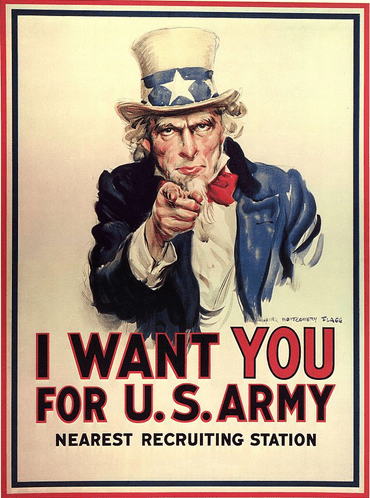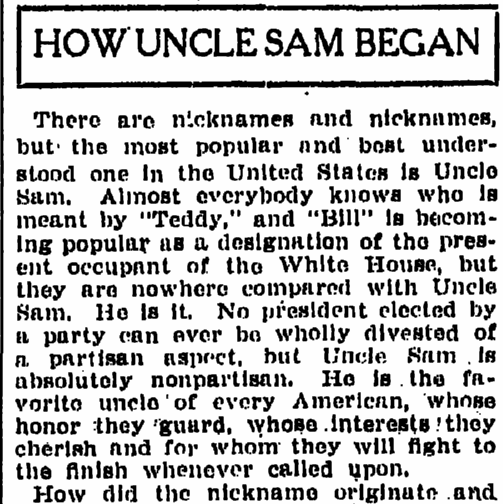Introduction: In this article, Scott Phillips searches old newspapers to learn more about the origins and history of an American icon: Uncle Sam. Scott is a genealogical historian and owner of Onward To Our Past® genealogy services.
All of us who love genealogy and family history know that every family member seems to have their own “favorite uncle.” I have two favorite uncles: Uncle Chuck Clark and Uncle Jim Vanek. I bet you have a favorite uncle or two as well, so it is only fitting that the entire United States should also have a favorite uncle. And who should that be but “Uncle Sam,” of course!

September is the month to celebrate Uncle Sam. For the past 25 years, every September 13th has been the National Day of the country’s favorite uncle. And while Uncle Sam Day has only been official since 1989, Uncle Sam has been with us a lot longer than that—and he makes for a colorful story.
Origins of Uncle Sam
This article from a 1910 Michigan newspaper begins with an Uncle Sam truism when it says: “There are nicknames and nicknames, but the most popular and best understood one in the United States is Uncle Sam.” Interestingly, this article also says that there are other national nicknames such as “John Bull” for the English and “Johnny Crapand” (crapand means a toad) for the French. I have to admit that while I do recall a rare use of “John Bull” now and again, the use of “Johnny Crapand” was a new one to me. But Uncle Sam still reverberates with national pride and recognition, even as these other nicknames have fallen out of fashion.

So where did the famous patriotic persona Uncle Sam come from? Was he just a figment of some talented artist somewhere or is he rooted in someone’s real history?
If you access the above article in GenealogyBank’s Historical Newspaper Archives and read it fully, it gives an account of the possible origin of Uncle Sam:
One story is that at the time of the war of 1812 there lived at Troy, N.Y., a man named Samuel Wilson, familiarly known thereabouts as Uncle Sam, who was employed as an inspector of pork and beef bought by the government.
However, the article goes on to say: “The story is so clumsy and improbable that it may safely be classed as untrue.” So I decided to continue looking.
As I continued searching the old newspapers, I did note that there were no references to Uncle Sam prior to 1812. An article from an 1814 New York newspaper caught my eye. This article contrasts how soldiers were paid by the U.S. (“Uncle Sam”) and British (“John Bull”) governments. Although it was interesting to learn about “Chequer Bills” and the phrase “Ready Rhino,” there was nothing in the article about Uncle Sam’s origins.
This 1817 Rhode Island newspaper article says the expression “Uncle Sam” began during the War of 1812 based on the initials “U.S.” stamped on soldiers’ knapsacks—and goes on to tell this amusing story:
The Indians at the west, from hearing it [Uncle Sam] often used, have imbibed the idea that it is actually the name of the President; and while at Sackett’s Harbor, a considerable number of Indians and Squaws crowded around the President, wishing, as they expressed it, ‘to shake hands with Uncle Sam.’
Thirteen years later, this Pennsylvania newspaper ran an article about the origins of Uncle Sam. This story relates the earlier story from the War of 1812 and the inspector of meat for the U.S. Army, Samuel Wilson, looking over meat purchased by a government contractor, one Elbert Anderson. On the barrels of these provisions was stamped “E.A. – U. S.”
The old newspaper article goes on:
This work [hauling the meat] fell to the lot of a facetious fellow in the employ [of Samuel Wilson] who, on being asked by some of his fellow workmen the meaning of the mark (for the letters U.S. for United States, was almost then entirely new to them) said ‘he did not know, unless it meant Elbert Anderson, and Uncle Sam’—alluding, exclusively, then to the said ‘Uncle Sam’ Wilson. The joke took among the workmen, and passed currently; and Uncle Sam himself being present, was occasionally rallied by them on the increasing extent of his possessions.
The 1800s news article concludes:
It [the joke about Uncle Sam] originated precisely as above stated; and the writer of this article distinctly recollects remarking, at the time when it first appeared in print, to a person who was equally aware of its origin, how odd it would be should this joke eventually become a national cognomen.
Iconic Artwork of James Flagg
Over the decades, Uncle Sam flourished as a symbol of the United States of America. Perhaps the most memorable image of our Uncle Sam was drawn by the famous pen-and-ink artist James Montgomery Flagg for a recruiting poster during World War I, with a stern-faced Uncle Sam pointing his finger and saying “I want you for U.S. Army!” You can see this famous image above, and also reprinted in this 1992 Alabama newspaper article, along with the attribution of the name to “Uncle Sam” Wilson again.
In 1960 James Flagg passed away, and his obituary stated:
His greatest work was his World War I recruiting poster of Uncle Sam pointing his finger and saying, ‘I want you.’
Brief Biography of Uncle Sam
This 1961 article from a Massachusetts newspaper gives us further background on “Uncle Sam” Wilson. It says that he was born in 1766 and died in 1854. He ran away from home to fight in the Revolutionary War. After the war he became a successful merchant and meat packer in Troy, New York, was quite a popular fellow and was universally known as “Uncle Sam.”
Who’s the Real Uncle Sam?
An article written by Blake Ehrlich in a 1961 Massachusetts newspaper brings to light the role of one Thomas Gerson in the life of Uncle Sam. Calling from his hospital bed to a reporter for the newspaper, Mr. Gerson explained he was the “Official Uncle Sam Historian and Director of Education for the Troy Area Committee for Uncle Sam.” It seems that Gerson, also “an editorial writer and feature man,” was on a mission to get the United States Congress to recognize his hometown hero, Samuel Wilson, as the “real” Uncle Sam. Interestingly, in this article we are introduced to yet another option for Uncle Sam’s origin. It seems Gerson was working to “triumph over the forces of evil from the state of Indiana, which tried to block the resolution with claims for its own Sam Wilson.”
It seems that the image of Uncle Sam has changed over the years, according to writer Ehrlich, having first appeared as a cartoon character in The Lantern, a comic weekly drawn by a fellow named Bellew in 1852. That Uncle Sam was dressed in a beaver hat, boots, and striped pants and was “tall, thin, with a clean-shaven hatchet face, much like Sam Wilson.” In the 1860s, cartoonist Thomas Nast added whiskers and a starry vest.
This 1961 Massachusetts newspaper article reported that historians in Indiana were still fighting Mr. Gerson’s efforts to recognize Troy’s Samuel Wilson as the one, true Uncle Sam, saying: “Indiana historians disagree, claiming the Troy meat packer was born in Wilmington, Del., and later moved to Merriam, Ind.”
This 1961 New Jersey newspaper reprinted an article from the Congressional Quarterly in Washington, D.C. This article, headlined “Interest Increasing in National Shrine,” tells us that the quibble over the “real” Uncle Sam continued even as “The nation also is about to doff its hat to ‘Uncle Sam,’ although it isn’t quite sure who ‘Uncle Sam’ was.” The article goes on to explain that the dust-up between New York and Indiana continued, reporting:
The New York Congressional delegation backs Samuel Wilson, a meat dealer who supplied the troops during the War of 1812 and who died in New York. The Indiana delegation backs a Samuel Wilson who earned the title of ‘Uncle Sam’ in Troy, but who is buried in Merriam, Ind.
And for good measure Connecticut was now in the act, believing:
the original ‘Uncle Sam’ was Sam Huntington of Connecticut, a signer of the Declaration of Independence and President of the Continental Congress.
And finally, there’s this:
The Texans are touting for ‘Uncle Sam’ none other than Sam Houston, beard and all.
While Indiana, Texas, and Connecticut were touting their Uncle Sam versions, New York was fast at work. This 1959 Washington newspaper article reported that then-Governor Nelson A. Rockefeller was declaring September 13th as “Uncle Sam Day” following a resolution passed by the State Legislature.
This 1988 Alabama newspaper published a sarcastic article by well-known columnist James J. Kilpatrick, in which he excoriated the recently-adjourned 100th U.S. Congress for accomplishing almost nothing, saying: “We are well rid of this Congress. Be gone! And don’t come back any time soon.”
To drive home his point, Kilpatrick pointed to the creation of Uncle Sam Day as one of the very few things the Congress did manage to do.
While it seems that Congress, in their infinite wisdom, decided for us who the “real” Uncle Sam was, I am now thinking I should really have some fun and start researching National Jukebox Week!
Related Articles about Famous American Icons: